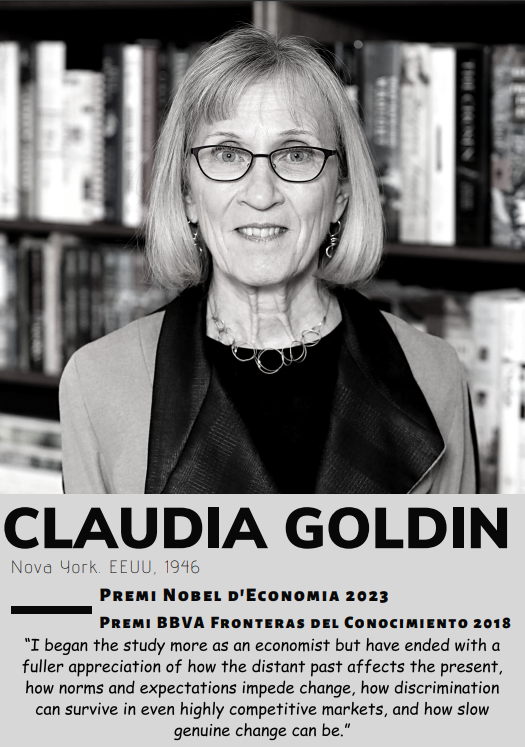Presentation of the 2023 Economics Nobel Prize

At 2:30 p.m. on November 28, in the "Sala de Graus" of the Schol, the Faculty of Economics and Business will recognize Claudia Goldin, awarded with the Bank of Sweden Prize in Economic Sciences in memory of Alfred Nobel 2023.
20/11/2023
On October 9, 2023, the Swedish Academy of Sciences announced the awarding of the Bank of Sweden Prize in Economic Sciences in memory of Alfred Nobel.
In this edition, the awardee has been Claudia Goldin , Henry Lee Professor of Economics at Harvard University for "providing the first comprehensive account of women's earnings and their participation in the labor market over the centuries. Her research reveals the causes of the gender gap, which still exists”
Claudia Goldin was elected Woman Economist of the Year by our Faculty in 2021 , and delivered the inaugural lecture for the 2021-2022 academic year on October 18, 2021.
Professor Carmen Sarasúa, Full professor of the Department of Economics and Economic History, will present the event in the Sala de Graus on November 28 at 2:30 p.m.
In connection with the awarding of this prize to Professor Claudia Goldin, the Library of Social Sciences has prepared an physical exhibition on the Ecoomics Nobel Prizes of the last 3 years, located in the display window to the left of the entrance to the Library, and a virtual exhibition that can be visited following this link (in Catalan).
Claudia Goldin. Henry Lee Professor of Economics, Harvard University.
Her ground-breaking research has provided new insights into the historical and contemporary role of women in the labor market and reveals new patterns, identifies the causes of change and addresses the main causes of why the gender gap persists.
The gender gap in income has decreased dramatically since the 1980s. Yet even in countries considered to be the most egalitarian, where women are more educated than men, women are less likely to work and, when they do, earn less than men.
In the early 1980s, Goldin took a comprehensive approach to assessing and explaining the sources of these differences in work and wages. After collecting, correcting, and analyzing more than 200 years of historical data from the United States, he found that women's labor force participation did not simply trend upward during this period, but instead forms a curve in the shape of of U.
Until the second half of the 20th century, the gender wage gap could be explained by differences in education and occupational choices. However, more recently, women with the same education often did the same jobs and still earned less. Goldin showed that most of these earnings differences between men and women in the same occupation occurred after the birth of their first child. One of the central findings of Goldin's research is that differences in wages and labor force participation are not due to biological differences but to differences in the division of unpaid caregiving responsibilities between heterosexual couples.
"Understanding the role of women in the labor market is fundamental for society," said Jakob Svensson, Chairman of the Economic Sciences Prize Committee 2023, during the Prize announcement. "If women do not have the same advantages and opportunities as men, or participate in them under unequal conditions, the workforce, the skills, the talent are wasted."